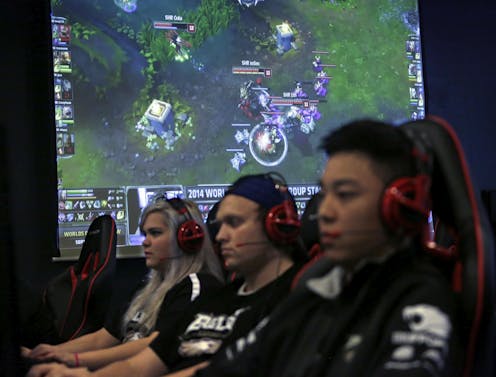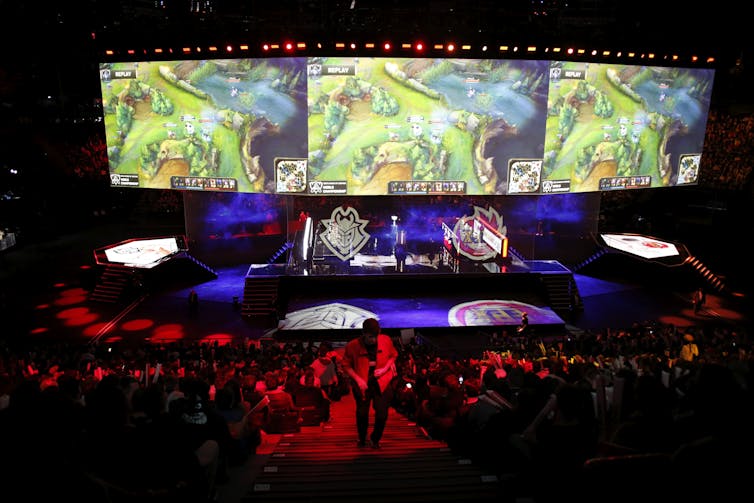Here's what it'll take to clean up esports' toxic culture
Combating sexism and other forms of harassment in online videogames comes down to community standards.

In day-to-day life, you probably haven’t had someone yell at you, “Get back in the kitchen and make me a sandwich!” If you’re a woman who plays online video games, though, statements like this, and worse, are all too common.
As COVID-19 has driven much of life online and fueled a boom in online gaming, harassment in these and other internet spaces has increased. Forty-one percent of computer and videogame players are female, down from 46% in 2019.
Despite its digital nature, online harassment can have real-world consequences for victims, including emotional and physical distress. This has left online gaming companies and players scrambling for better community management techniques to prevent harassment. As a researcher who studies gaming, I’ve found that the right cultural norms can result in healthy online communities, even in the highly competitive world of esports.
The stakes are high. Competitive video gaming, or esports, now exceeds US$1 billion in yearly revenue. Professional, collegiate and high school leagues are expanding, especially as COVID-19 has decreased opportunities for traditional sports.
History of harassment
Recent stories from The New York Times, Wired, Insider and others have highlighted how pervasive sexism, racism, homophobia and other forms of discrimination are in online spaces. However, these issues are hardly new. Similar problems arose in 2014’s GamerGate Twitter-based campaign of harassment of female gamers, designers and journalists.
Sexism was also common before GamerGate. For example, professional gamer Miranda Pakozdi quit her team following sexual harassment from her coach in 2012; the coach, Aris Bakhtanians, famously stated that “sexual harassment is part of [the fighting game] culture” and that it could not be removed.
Others have suggested that the anonymity of online game spaces, combined with gamers’ competitive natures, increases the likelihood of toxic behavior. Survey data from the American Defamation League suggests that at least 37% of female gamers have faced gender-based harassment.
However, positive online communities exist, and a study by lawyer and former Microsoft user experience designer Rebecca Chui found that anonymous online communities are not inherently toxic. Rather, a culture of harassment requires community norms that allow for it. This suggests that online bad behavior can be addressed effectively. The question is how.

Players’ coping strategies
In my interview-based research with female gamers, I’ve found that players have many strategies for avoiding or managing online harassment. For instance, some play only with friends or avoid using voice chat to hide their gender. Other gamers get really good at their favorite games, to shut down harassment through skill. Research by other media scholars, such as Kishonna Gray and Stephanie Ortiz, has found similar results across race and sexuality.
These strategies have significant downsides, however. For example, ignoring toxicity or brushing it off allows it to persist. Pushing back against harassers often results in further harassment.
They can also put the burden of challenging harassment on the victim, rather than on the perpetrator or community. This can drive victims out of online spaces. As my interviewees gained responsibilities in their jobs or families, for instance, they no longer had the time or energy to manage harassment and stopped gaming. My research suggests that game companies need to intervene in their communities to keep players from having to go it alone.
How companies can intervene
Game companies are becoming increasingly invested in community management strategies. Large publisher Electronic Arts held a community management summit in 2019, and companies like Microsoft and Intel are developing new tools for managing online spaces. A group of game development companies even recently formed the Fair Play Alliance, a coalition working to address harassment and discrimination in gaming.
It’s important that interventions be rooted in the experiences of players, however. Right now, many companies intervene though practices like banning or blocking harassers. For instance, the live-streaming platform Twitch recently banned several prominent streamers following allegations that they had committed sexual harassment.
This is a start, but harassers who are blocked or banned often create new accounts and return to their previous behaviors. Blocking also manages harassment after it occurs, rather than stopping it at the source. Thus blocking should be combined with other potential approaches.
First, companies should expand the tools they provide players to manage their online identities. Many participants avoided voice chat to limit gender harassment. This at times made it difficult to compete. Games like Fortnite, League of Legends and Apex Legends, however, have instituted “ping” systems, where players can communicate essential game information rapidly, without requiring voice. Similar tools could be built into many other online games.
Another option my interviewees suggested is to make it easy for players to group with friends, so they have someone on their side to guard against harassment. Grouping mechanisms work particularly well when matched to the needs of their specific game. For instance, in games like Overwatch and League of Legends, players need to take on different roles to balance their team. Abuse can occur when randomly assigned teammates all want to play the same character.
Overwatch recently introduced a new grouping system that allows players to choose their characters, then be matched with players who have chosen different roles. This appears to reduce abusive in-game chat.

Finally, companies should work to change their basic cultural norms. For example, League of Legends publisher Riot Games once instituted a “Tribunal” system where players could view incident reports and vote on whether the behavior was acceptable in the League community.
[Deep knowledge, daily. Sign up for The Conversation’s newsletter.]
Although Riot Games unfortunately closed the Tribunal shortly after its release, including community members in any solution is a good idea. Companies should also develop clear community guidelines, encourage positive behavior through tools like in-game accolades, and respond to ongoing issues rapidly and decisively.
If esports continue to expand without game companies addressing the toxic environments in their games, abusive and exclusionary behaviors are likely to become entrenched. To avoid this, players, coaches, teams, leagues, game companies and live-streaming services should invest in better community management efforts.
Amanda Cote does not work for, consult, own shares in or receive funding from any company or organisation that would benefit from this article, and has disclosed no relevant affiliations beyond their academic appointment.
Read These Next
The celibate, dancing Shakers were once seen as a threat to society – 250 years later, they’re part
‘The Testament of Ann Lee,’ Mona Fastvold’s 2025 film, depicts part of the long history of Shaker…
From truce in the trenches to cocktails at the consulate: How Christmas diplomacy seeks to exploit s
World leaders like to talk up peace at Christmastime. But alongside the tales of seasonal breaks in…
As DOJ begins to release Epstein files, his many victims deserve more attention than the powerful me
Powerful men connected to Jeffrey Epstein are named, dissected and speculated about. The survivors,…





